Main Scientific Goals
The main scientific objectives of this programme are:
Long-term high quality observations of reactive gases (CO, NOx, SO2) in both the free troposphere (FT) and the Marine Boundary Layer (MBL) to support other measurement programmes at IARC.
Long-term high quality observations and analysis of tropospheric O3 in the FT and in the MBL.
Air quality studies in urban and background conditions. Analysis of long-range transport of pollution (e.g. transport of anthropogenic and wildfire pollution from North America).
Study of the impact of dust and water vapour on tropospheric O3.
Analysis and characterization of the Upper Troposphere-Lower Stratosphere (UTLS).
Analysis of Stratosphere-Troposphere Exchange processes.
Measurement Programme
Details of the reactive gases and ozonesondes measurement programme are described in González (2012) and Cuevas et al. (2013). The surface O3 programme is considered a particularly important programme at IZO due to both free troposphere conditions of the site and the quality and length of the data series. The almost uninterrupted 32-year time series of surface O3 at IZO is shown in Fig. 5.2. Surface O3 data at IZO have been calibrated against references that are traceable to the US National Institute for Standards and Technology (NIST) reference O3 photometer (Gaithersburg, Maryland, USA). The surface O3 programme at IZO has been audited by the World Calibration Centre for Surface Ozone, Carbon Monoxide, Methane and Carbon Dioxide (WCC-Ozone-CO-CH4-CO2-EMPA) in 1996, 1998, 2000, 2004, 2009, 2013 and 2019.
EMPA’s audit reports are available here.
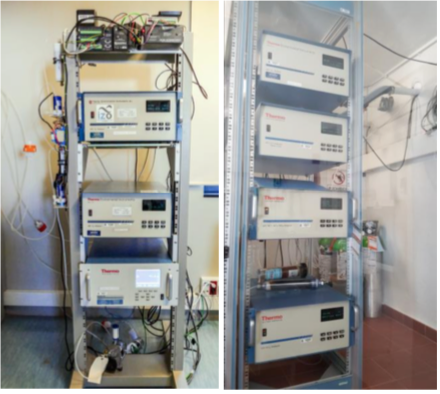
Reactive gases analysers. Left panel: Izaña Atmospheric Observatory. Right panel: Santa Cruz Observatory.
The measurement programme of reactive gases (O3, CO, NOx and SO2) includes long-term observations at IZO, SCO and BTO and ozonesonde vertical profiles at Tenerife (now at BTO). In addition, IARC (through AEMET and INTA) has a long- term collaboration with the Argentinian Meteorological Service (SMN) and in the framework of this collaboration, ozone vertical profiles are measured at Ushuaia GAW Global station (Argentina). Surface O3 measurements started in 1987, CO in 2004, and SO2 and NOx measurements were implemented in 2006 at IZO. At SCO, surface O3 measurements started in 2001, and CO, SO2 and NOx programmes were also implemented in 2006.
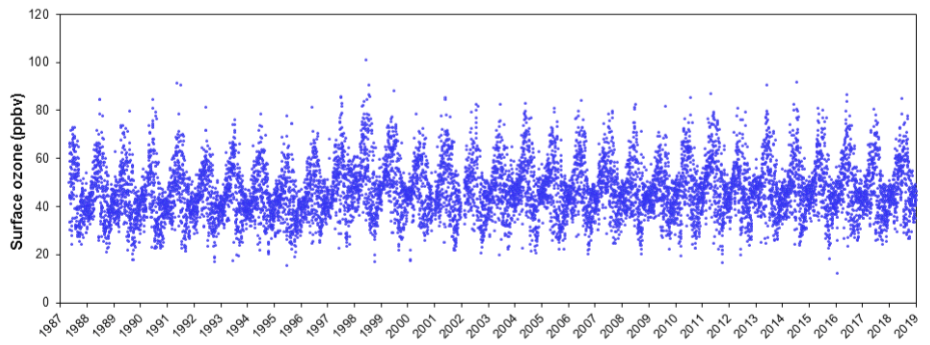
Long-term daily (night period) surface O3 at IZO (1987-2018)
NOx and SO2 instruments at IZO usually operate below the detection limit (50 pptv) during the night-time period when we can ensure background conditions. However, these measurements are quite useful for studies of local or regional pollution during daytime, when concentrations are modulated by valley-mountain breeze, and help to understand the impact of regional pollution. A detailed description of these measurement programmes, including quality control and quality assurance protocols is provided by González (2012).
In order to significantly improve the NO-NO2-NOx measurement programme, in 2018 we requested a new NO- NO2-NOx analyzer from the Spanish National R&D call for scientific infrastructure funding. The infrastructure project was approved at the end of 2018, and the new equipment is expected to be installed by the end of 2019. Given the background atmospheric conditions of IZO, a NO-NO2-NOx analyzer with a greater sensitivity than the chemical- luminescent detector (CLD) for the determination of NO and NO2, with detection limits of the order of 10 ppt for NO and 20 ppt for NO2 is required. The new instrument selected is the ECO PHYSICS CraNOx II. This instrument also has a double channel to perform simultaneous measurements of NO and NOx, and O3 to correct the NOx measurements of O interference during the photolysis reaction.
CO is measured with high accuracy at IZO by the Greenhouse Gases and Carbon Cycle Programme, following the GAW recommendations. CO measurements are also performed at SCO with the non-dispersive IR absorption technique and utilized for air quality research.
Instruments
The methodologies used by the in situ analyzers have been declared as reference methods by the Environmental Protection Agency of USA and the European Union.
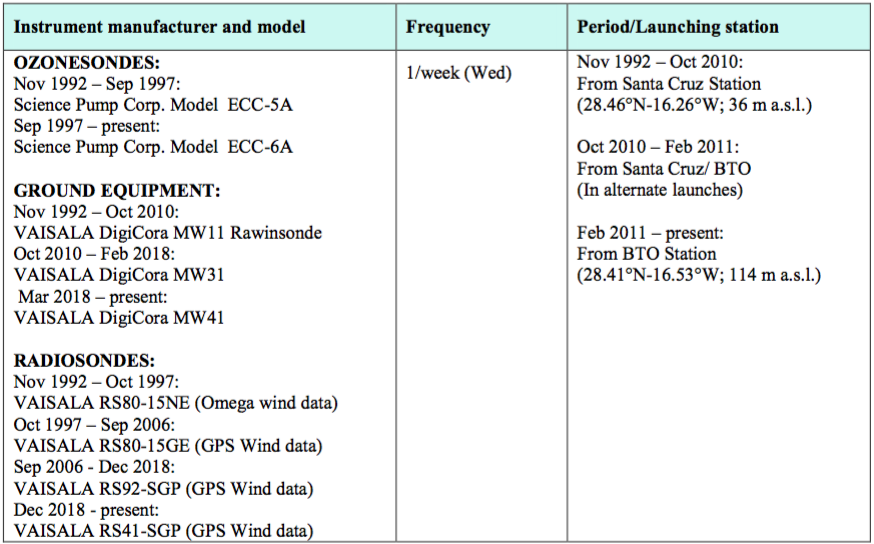
Table: Ozonesonde Programme equipment used in different time periods and launching stations since November 1992.
Ozonesonde vertical profiles
The ozone vertical profile measurements were initiated in November 1992 using the Electrochemical concentration cell (ECC) ozonesonde technique. Launches are performed once a week (Wednesday). The frequency of ozone soundings in this station is significantly increased during intensive campaigns.
At the start of the programme, the ozonesondes were launched from Santa Cruz Station and since 2011 they have been launched from BTO. This programme provides ozone profiles from the ground to the burst level (generally between 30 and 35 km) with a resolution of about 10 metres. A constant mixing ratio above burst level is assumed for the determination of the residual ozone if an altitude equivalent to 17 hPa has been reached.
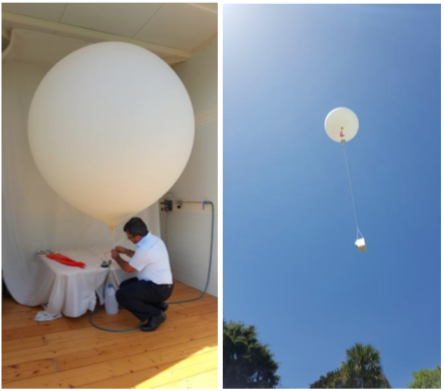
Marcos Damas preparing the ozonesonde for launch and b) launch of ozonesonde at BTO
Ozonesondes are checked before launching with a Ground Test with Ozonizer/Test Unit TSC-1 (see Section 3.2.2 and Fig. 5.4). The ECC-ozone sensor used is an electrochemical cell consisting of two half cells, made of Teflon, which serve as cathode and anode chambers, respectively. Both half cells contain platinum mesh electrodes. They are immersed in a KI-solution, always with the same sensing solution type (SST1.0: 1.0% KI & full pH-buffer) since the beginning of the Ozonesonde Programme (Nov 1992). The two chambers are linked together by an ion bridge in order to provide an ion pathway and to prevent mixing of the cathode- and anode electrolytes.
The main features of the ozonesonde system currently in use are the following:
- Sensor: ECC-6A
- Balloon: TOTEX TA 1200
- Radiosonde: RS-41
- Receiver: DigiCora MW41
- Wind system: GPS
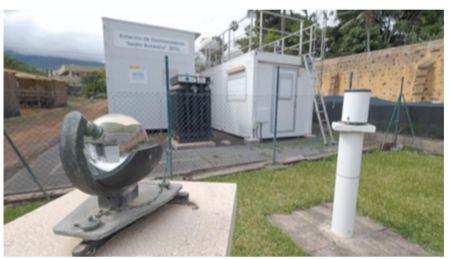
BTO ozonesonde launching station
Publications based on reactive gases observations
Cuevas, E., González, Y., Rodríguez, S., Guerra, J. C., Gómez- Peláez, A. J., Alonso-Pérez, S., Bustos, J., and Milford, C.: Assessment of atmospheric processes driving ozone variations in the subtropical North Atlantic free troposphere, Atmos. Chem. Phys., 13, 1973-1998, doi:10.5194/acp-13-1973-2013, 2013.
Gaudel, A, O. R. Cooper, G. Ancellet, B. Barret, A. Boynard, J. P. Burrows, C. Clerbaux, P.-F. Coheur, J. Cuesta, E. Cuevas, S. Doniki, G. Dufour, F. Ebojie, G. Foret, O. Garcia, M. J. Granados-Muñoz, J. W. Hannigan, F. Hase, B. Hassler, G. Huang, D. Hurtmans, D. Jaffe, N. Jones, P. Kalabokas, B. Kerridge, S. Kulawik, B. Latter, T. Leblanc, E. Le Flochmoën, W. Lin, J. Liu, X. Liu, E. Mahieu, A. McClure-Begley, J. L. Neu, M. Osman, M. Palm, H. Petetin, I. Petropavlovskikh, R. Querel, N. Rahpoe, A. Rozanov, M. G. Schultz, J. Schwab, R. Siddans, D. Smale, M. Steinbacher, H. Tanimoto, D. W. Tarasick, V. Thouret, A. M. Thompson, T. Trickl, E. Weatherhead, C. Wespes, H. M. Worden, C. Vigouroux, X. Xu, G. Zeng, J. Ziemke: The Tropospheric Ozone Assessment Report: Present-day distribution and trends of tropospheric ozone relevant to climate and global atmospheric chemistry model evaluation, Elem Sci Anth, 6: 39. DOI: https://doi.org/10.1525/elementa.291, 2018.
González, Y., Levels and origin of reactive gases and their relationship with aerosols in the proximity of the emission sources and in the free troposphere at Tenerife, PhD Thesis, Technical Note No 12, AEMET, NIPO 281-12-016-1, July 2012.
Huang, G., Liu, X., Chance, K., Yang, K., Bhartia, P. K., Cai, Z., Allaart, M., Ancellet, G., Calpini, B., Coetzee, G. J. R., Cuevas- Agulló, E., Cupeiro, M., De Backer, H., Dubey, M. K., Fuelberg, H. E., Fujiwara, M., Godin-Beekmann, S., Hall, T. J., Johnson, B., Joseph, E., Kivi, R., Kois, B., Komala, N., König- Langlo, G., Laneve, G., Leblanc, T., Marchand, M., Minschwaner, K. R., Morris, G., Newchurch, M. J., Ogino, S.- Y., Ohkawara, N., Piters, A. J. M., Posny, F., Querel, R., Scheele, R., Schmidlin, F. J., Schnell, R. C., Schrems, O., Selkirk, H., Shiotani, M., Skrivánková, P., Stübi, R., Taha, G., Tarasick, D. W., Thompson, A. M., Thouret, V., Tully, M. B., Van Malderen, R., Vömel, H., von der Gathen, P., Witte, J. C., and Yela, M.: Validation of 10-year SAO OMI Ozone Profile (PROFOZ) product using ozonesonde observations, Atmos. Meas. Tech., 10, 2455-2475, https://doi.org/10.5194/amt-10- 2455-2017, 2017.
Schultz, M. G., Schröder, S., Lyapina, O., Cooper, O. R., Galbally, I., Petropavlovskikh, I., von Schneidemesser, E., Tanimoto, H., Elshorbany, Y., Naja, M., Seguel, R. J., Dauert, U., Eckhardt, P., Feigenspan, S., Fiebig, M., Hjellbrekke, A.-G., Hong, Y.- D., Kjeld, P. Ch., Koide, H., Lear, G., Tarasick, D., Ueno, M., Wallasch, M., Baumgardner, D., Chuang, M.-T-, Gillett, R., Lee, M., Molloy, S., Moolla, R., Wang, T., Sharps, K., Adame, J.A., Ancellet, G., Apadula, F., Artaxo, P., Barlasina, M.E., Bogucka, M., Bonasoni, P., Chang, L., Colomb, A., Cuevas- Agulló, E., Cupeiro, M., Degorska, A., Ding, A., Fröhlich, M., Frolova, M., Gadhavi, H., Gheusi, F., Gilge, S., Gonzalez, M.Y., Gros, V., Hamad, S.H. Helmig, D., Henriques, D., Hermansen, O., Holla, R., Hueber, J., Im, U., Jaffe, D.A; Komala, N., Kubistin, D., Lam, K.-S., Laurila, T., Lee, H., Levy, I., Mazzoleni, C., Mazzoleni, L., McClure-Begley, A., Mohamad, M., Murovec, M., Navarro-Comas, M., Nicodim, F., Parrish, D., Read, K.A., Reid, N., Ries, L., Saxena, P., Schwab, J.J, Scorgie, Y., Senik, I., Simmonds, P., Sinha, V., Skorokhod, A.I., Spain, G., Spangl, W., Spoor, R., Springston, S.R., Steer, K., Steinbacher, M., Suharguniyawan, E., Torre, P., Trickl, T., Weili, L., Weller, R., Xu, X., Xue, L., Zhiqiang, M.: : Tropospheric Ozone Assessment Report, links to Global surface ozone datasetsx. PANGAEA, https://doi.org/10.1594/PANGAEA.876108, Supplement to: Schultz, MG et al. (2017): Tropospheric Ozone Assessment Report: Database and Metrics Data of Global Surface Ozone Observations, Elementa – Science of the Anthropocene, 5:58, 26 pp, https://doi.org/10.1525/elementa.244, 2017.
Smit, H. G. J., Oltmans, S., Deshler, T., Tarasick, D., Johnson, B., Schmidlin, F., Stübi, R., and Davies, J.: SI2N/O3S-DQA Activity: Guide Lines for Homogenization of Ozone Sonde Data, version 19 November 2012, available at: http://www- das.uwyo.edu/~deshler/NDACC_O3Sondes/O3s_DQA/O3S- DQA-Guidelines%20Homogenization-V2- 19November2012.pdf, 2012.
Smit, H.G.J., and the Panel for the Assessment of Standard Operating Procedures for Ozonesondes (ASOPOS), Quality Assurance and Quality Control for Ozonesonde Measurements in GAW, GAW Report No. 201, World Meteorological Organization (WMO), 92 pp, 2013.
Staff
Carlos Torres (AEMET; Head of programme)
Dr Emilio Cuevas (AEMET)
Dr Natalia Prats (AEMET)
Ramón Ramos (AEMET; Head of Infrastructure)
Sergio Afonso (AEMET; Meteorological Observer-GAW Technician)
Virgilio Carreño (AEMET; Meteorological Observer- GAW Technician)
Nayra Chinea (SIELTEC Canarias / TRAGSATEC; Calibrations and ozonesonde technician)
———————————–
